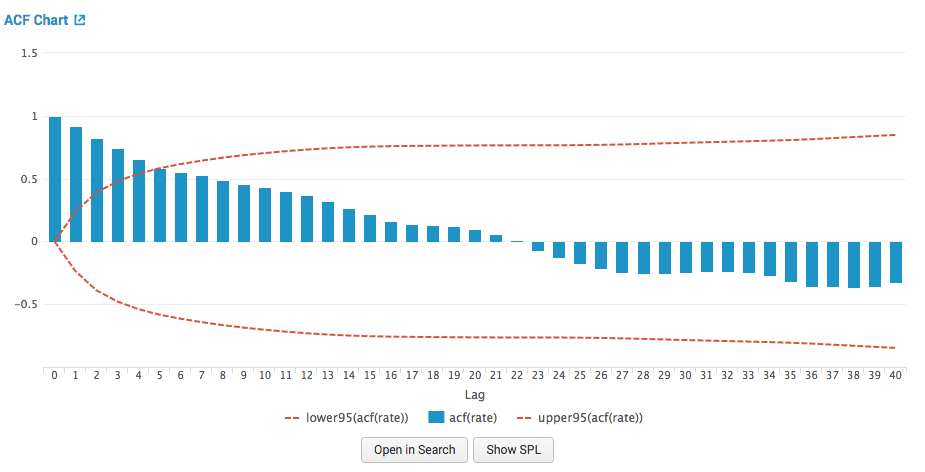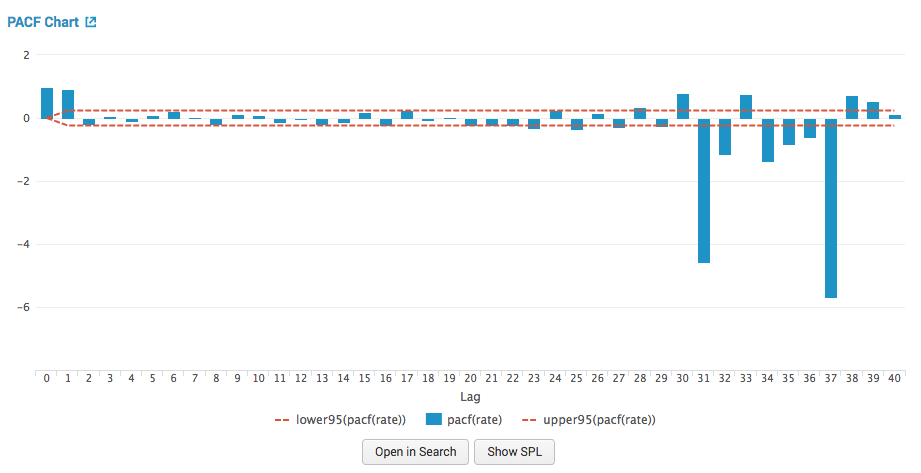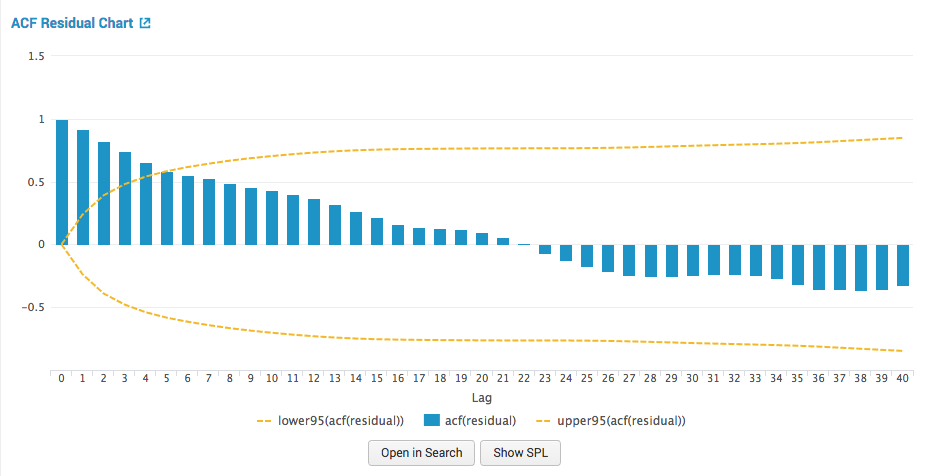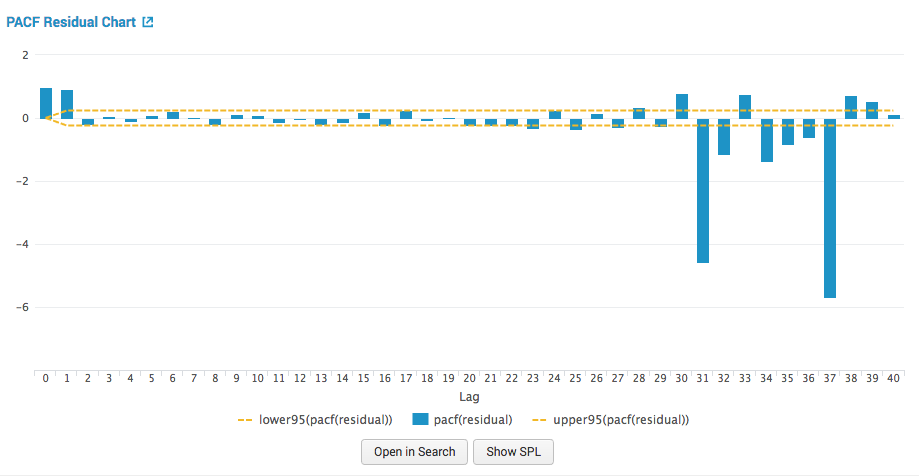Forecast Time Series
The Forecast Time Series assistant predicts the next value in a sequence of time series data. The result includes both the predicted value and a measure of the uncertainty of that prediction.
Forecasting is one type of prediction. Forecasting refers to the use of past time series data to make predictions.
Algorithms
The Forecast Time Series assistant can use the following algorithms:
- State-space method using Kalman filter
- AutoRegressive Integrated Moving Average (ARIMA)
Workflow
Forecast a time series as follows:
- From the Assistants menu, select Forecast Time Series.
- Run a search from the search bar.
- From the Algorithms menu, select an algorithm. If you are not sure which algorithm to choose, start with the default algorithm, the Kalman filter.
- From the Field to Forecast list, select the field you want to forecast. The Field to Forecast list is populated with fields from the search.
- Select the parameters:
- if you chose the Kalman filter algorithm in step 2, select a forecasting method. These methods consider subsets of features such as local level (an average of recent values), trend (a slope of line that fits through recent values), and seasonality (repeating patterns).
- if you chose the ARIMA algorithm in step 2, specify the values for AR (autoregressive) - p, I (integrated) - d, MA (moving average) - q parameters. For example, AR(1) means you would forecast future values by looking at 1 past value. I(1) means it took 1 difference, where each data point was subtracted from the one that follows it, to make the time series stationary. MA(1) means you would forecast future values using 1 previous prediction error.
- Specify the future timespan, which indicates how far beyond the data you want to forecast. The size of the confidence interval is used to gauge how confident the algorithm is in its forecast.
- Specify the number of values to withhold, which indicates how many search results to use for validating the quality of the forecast. The larger the withholding, the less is available to train your model.
- Select the confidence interval, which is the percentage of the future data you expect to fall inside of the confidence envelope.
- For the Kalman algorithm, select the period, which indicates the period of any known repeating patterns in the data to assist the algorithm. For example, if your data includes monthly sales data that follows annual patterns, specify 12 for the period.
- Click Forecast.
Interpret and validate
- Raw Data Preview: Displays the raw data from the search.
- Forecast: In shades of brown and beige, a graph displays the actual value as a solid line and the predicted value as a dotted line, surrounded by a confidence envelope. Values that fall outside the confidence envelope are outliers. A vertical line indicates where training data stops and test data begins. When the real data ends, forecasted values are displayed in shades of green.
- R2 Statistic: Represents how well the model explains the variability of the result. 100% (a value of 1) means the model fits perfectly.
- Root Mean Squared Error: Explains the variability of the result, which is essentially the standard deviation of the residual. The formula takes the difference between actual and predicted values, squares this value, takes an average, and then takes a square root.
- Prediction Outliers: Shows the total number of outliers that were detected.
Interpretation: The larger the envelope, the less confidence we have about forecasts around that time. The size of the envelope is directly related to the specified confidence interval percentage.
Interpretation: The closer the value is to 1 (100%), the better the result.
Interpretation: This value can be arbitrarily large and just gives you an idea of how close or far the model is. These values only make sense within one dataset however, and shouldn't be compared to values outside of it.
Predicting with the ARIMA algorithm
When predicting using the ARIMA algorithm, additional autocorrelation panels are present. Autocorrelation charts can be used to estimate and identify the three main parameters for the model:
- the autoregressive component
p - the integrated component or order of differencing
d - the moving average component
q
ACF: Autocorrelation function chart
The autocorrelation function chart shows the predicted field's autocorrelations at various lags, surrounded by confidence interval lines. For example, the column at lag 1 shows the amount of correlation between the time series and a lagged version of itself.

PACF: Partial autocorrelation function chart
The partial autocorrelation function chart shows the predicted field's autocorrelations at various lags while controlling for the amount of correlation contributed by earlier lag points. This chart is also surrounded by confidence interval lines. For example, the column at lag 2 shows the amount of correlation between the time series and a lagged version of itself, while removing the correlation contributed by the lag 1 data points.

ACF Residual: Autocorrelation function residual chart
The autocorrelation function residual chart shows prediction errors. The errors are the difference between the series and the predictions. The ACF of the residuals should be close to zero. If the errors are highly correlated, the model may be poorly parameterized or the series may not be stationary.

PACF Residual: partial autocorrelation function residual chart
The partial autocorrelation function chart shows prediction errors. The errors are the difference between the series and the predictions. The PACF of the residuals should be close to zero. If the errors are highly correlated, the model may be poorly parameterized or the series may not be stationary.

Refine the forecast
After you create a forecast, you can select a different algorithm to see whether a different choice yields better results, but the quality of the forecast mostly depends on how predictable the data is.
Deploy the forecast
Once you have validated and refined a forecast and are satisfied with it, you can take the following actions:
- Click the Open in Search button next to the Forecast button to open a new Search tab with the search query.
- Click the Show SPL button next to the Open in Search button to see the search query that was used to calculate the forecast. You can use this same query on a different data set.
- Click the Schedule Alert button in a panel to create an alert for when a prediction meets criteria you set. After you save the alert, you can access it from the Scheduled Jobs > Alerts menu.
- Click any title to go to a new Search tab, populated with the search query used for the visualization.
| Detect Categorical Outliers | Cluster Numeric Events |
This documentation applies to the following versions of Splunk® Machine Learning Toolkit: 2.3.0

 Download manual
Download manual
Feedback submitted, thanks!